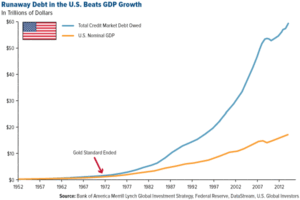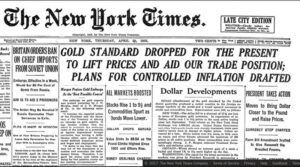Lesson 6: The Fall of the Gold Standard
While the gold standard provided decades of economic stability, it was not immune to the pressures of the 20th century. The outbreak of World War I in 1914 marked the beginning of the end for the classical gold standard. The war put immense strain on national economies, as governments borrowed heavily to finance military operations. In many cases, governments were forced to abandon the gold standard in order to print more money to fund the war effort.

The strain of World War I led to the collapse of the classical gold standard in many countries. The British government, for example, temporarily suspended the convertibility of the pound into gold in 1914, as it needed to increase the money supply to finance the war. Other nations followed suit, and by the end of the war, the gold standard had been effectively abandoned by most countries. While some countries tried to return to the gold standard after the war, the system was no longer as robust as it had been before.
The Great Depression of the 1930s further exacerbated the challenges facing the gold standard. In the United States, the stock market crash of 1929 and the subsequent economic collapse led to a banking crisis and widespread unemployment. To combat the effects of the depression, President Franklin D. Roosevelt took the drastic step of abandoning the gold standard in 1933. Under the new policies, the U.S. government confiscated gold from citizens, and the dollar was no longer directly tied to gold. This marked a significant shift in the way money was valued, as the government could now print money without the constraint of gold reserves.

In 1944, the Bretton Woods Agreement established a new global financial system in which the U.S. dollar became the world’s reserve currency, with its value still tied to gold. Under the Bretton Woods system, countries agreed to peg their currencies to the U.S. dollar, which was convertible into gold at a fixed rate of $35 per ounce. This system provided some stability during the post-war period and helped rebuild the global economy. However, by the 1970s, the U.S. economy faced mounting pressure from inflation, trade imbalances, and the cost of the Vietnam War. In 1971, President Richard Nixon announced that the U.S. would no longer convert dollars into gold, effectively ending the Bretton Woods system and the last vestiges of the gold standard.
The fall of the gold standard marked a profound shift in the global financial system. The abandonment of gold-backed currencies led to the rise of fiat money—currencies that are not backed by any physical commodity but rather derive their value from the trust and confidence that people place in the issuing government. While this shift allowed for greater flexibility in monetary policy, it also introduced new risks, particularly the risk of inflation and currency devaluation. The history of the gold standard, and its eventual collapse, highlights the complexities of monetary systems and the delicate balance between stability and flexibility.
